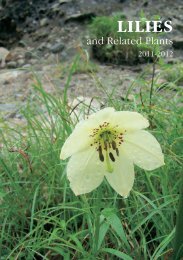LILIES - RHS Lily Group
LILIES - RHS Lily Group
LILIES - RHS Lily Group
You also want an ePaper? Increase the reach of your titles
YUMPU automatically turns print PDFs into web optimized ePapers that Google loves.
shaped hybrids, a variety of different aurelian hybrids was developed. These<br />
breeds are rarely affected by disease. At most they are sensitive to late frosts,<br />
which can impair their flowering. Carl Feldmaier, the German lily breeder,<br />
describes the aurelian lilies as extremely fool proof.<br />
Pink trumpets with trumpet shaped blooms developed following specific<br />
selection processes. L. N. Freimann from Washington noticed pink petals on one<br />
of his seedlings. He crossbred the hybrid over several generations, selecting<br />
the best seedlings for breeding, until he finally obtained lilies with fuchsia pink<br />
petals. The disadvantage was that the third generation was greatly weakened by<br />
the interbreeding, so he was forced to backcross it with Lilium regale until he<br />
was finally able to sell the “pink trumpets”.<br />
This programme took 15 years. The “king lilies” were developed in a similar<br />
way. In 1941 Freimann sowed some Lilium x gloriosum seed; amongst the<br />
seedlings he found one that was cream-coloured. After five years of back-crossing<br />
and much selection the “golden regales” were introduced in 1946. When one is<br />
talking of yellow and golden trumpet lilies, one breeder must not be forgotten<br />
– Jan de Graaff from the Oregon Bulb Farms. In 1934 the Dutchman emigrated to<br />
America, he bought land and planted narcissus and iris bulbs. At the same time,<br />
lilies fascinated him, so he collected whatever he could get and bred selectively.<br />
From de Graaff’s selection came the white hybrids that are divided into two<br />
groups: the “mountain-hybrid” that have a touch of green and the classic white<br />
“Olympic-hybrid”.<br />
Trumpet lilies are usually divided in four main groups: the ones with Chinese<br />
trumpet flowers (6a), the ones with cup or pod shaped flowers (6b), the ones<br />
with hanging flowers (6c), and, finally, the ones with star shaped flowers (6d).<br />
Trumpet lilies are easily grown in a humus-rich sandy soil, with their heads<br />
in the sun and feet in the shade. Due to their high bud count, trumpet lilies are<br />
more suited to the garden than to the cut flower trade, which has not made wide<br />
use of trumpet lilies because of the problems involved when transporting the<br />
plants (buds easily damaged…etc). Trumpet lilies, as previously mentioned, can<br />
be very free flowering. One variety (‘Heidelberg’) produced 66 flowers! Another<br />
hybrid, ‘Glockenturm’, was photographed with 30 flowers.<br />
Trumpet lilies are rarely found in florists. For the garden however a wide range<br />
of different new hybrids are now available, making it worthwhile for everyone to<br />
try for themselves.<br />
The Editor would like to thank Pontus Wallstén who assisted with the translation of this<br />
article which was kindly undertaken by Gesa Hille.<br />
90




